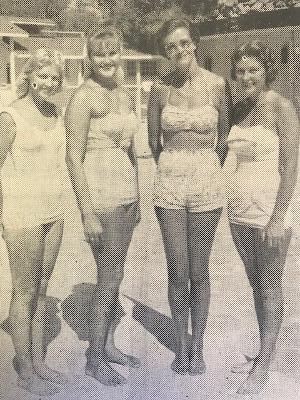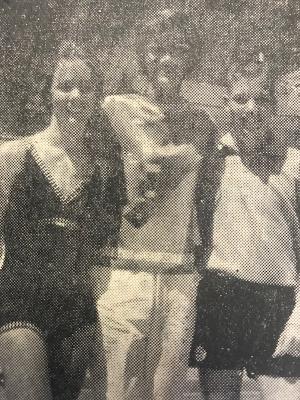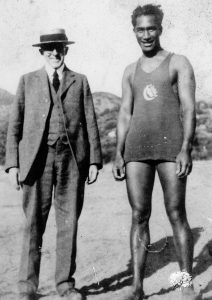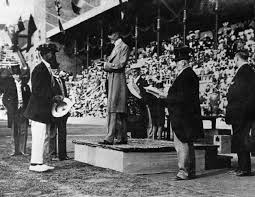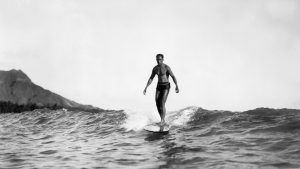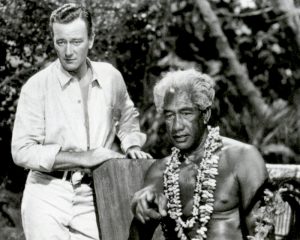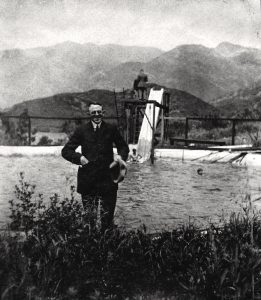The following article was first printed in the Thursday, August 25, 1960 edition of “THE OJAI PRESS” on Page 7. “THE OJAI PRESS” became the “OJAI VALLEY NEWS.” It is reprinted here with their permission. The author is unknown.
Twelve Records Set At Matilija Meet
Twelve swimming records at the Matilija pool were broken during the third annual Ojai Valley swimming meet, Saturday at 11 a.m.
“A high level of excitement and enthusiasm were important in the times achieved,” according to Ojai’s director of parks and recreation Jerry Minford.
Matilija’s pool is seven feet longer than regulation, Minford explained, and the times are a little slower than they would be in a regulation pool, he added.
Typical of the records broken were the backstroke competition: girls, 10 years and under, Beverly Tyoison, 27.02; boys, 10 years and under, Craig Brown, 24.05; girls, 11 and 12 years, Roni Brown, 49.08; girls, 15 and 16 years, Sue Capune, 44.01. In the butterfly, 12 and under girls, Roni Brown, 20.02; boys 13 and 14 years, Billy Hayes, 48.04.
In the freestyle Robby Brown won the six year and under boys competition with a time of 8.01; girls, seven and eight years, Krissie Brown, 22.0; girls, 11 and 12 years, Susan Wendohl, 37.05; girls, 15 and 16, Sue Capune, 36.05.
Craig Brown took the top time in the ten year and under boys breast stroke with a time of 55.03; boys, 13 and 14, Billy Hayes; girls, 15 and 16 years, Sue Capune.
In the individual races, the swimmers were placed as follows: In the butterfly, girls 12 and under, first, Roni Brown, second, Mary Mahon, third, Mary Mahon. In the boys’ 13 and 14 year butterfly competition: first, Billy Hayes, second, Paul Booker. Boys, 15 and 16 years, first Don McIntosh, second, Bob Waggoner, third, Jack Morrison.
In the breaststroke: Girls, 10 years and under: first, Elizabeth Yunger, second, Krissie Brown, third, Carol Mahonm. Boys, 10 and under: first, Craig Brown, second, Steve Olson. Girls, 11 and 12 years: first, Mary Mahon, second, Barbara Yunger, third, Susan Lopez. Boys, 11 and 12 years: first, Kevin Yunger, second, Bobby Christianson. Girls, 13 and 14 years: first, Jan Farnsworth, second, Monica Michalski, third Monica Michalski. Boys, 13 and 14 years: first, Billy Hayes, second, Paul Booker. Girls, 15 and 16: first, Sue Capune, second, Bunny Brunette. Boys, 15 and 16: first, Tom Helm, second, Don McIntosh, third, Jack Morrison.
In the freestyle: Girls, six and under: first, Victoria Rogers, second, DeDe Wilson, third, JoAnn Ledford. Boys, six and under: first, Robbie Brown, second, Lanny Morrill, third, Johnathon Morrill. Girls, seven and eight years: first, Krissie Brown, second, Elizabeth Yunger, third, Susan Chess. Boys, seven and eight years: first, James Gamble, second, Henry Mahon, third, Jeff Norcott. Girls, nine and 10: first, Carol Mahon, second, Susan Bower, third, Anne Chess. Boys, nine and 10: first, Lance Farnsworth, second, Craig Brown, third, Jimmy Nelson. Girls, 11 and 12: first, Susan Wendohl, second, Roni Brown, third, Mary Mahon. Boys, 11 and 12: first, Bobby Christianson, second, Kevin Yunger, third, Charles Miller. Girls, 13 and 14: Monica Michalski, second, Michele Michalski, third, Jan Farnsworth. Boys, 13 and 14: first, Billy Hayes, second, Jimmy Christianson, third, Paul Booker. Girls, 15 and 16: first, Sue Capune, second, Bunny Brunette, third, Eileen Jacobs. Boys, 15 and 16: first, Kirk Spicer, second, Jack Morrison, third, Don McIntosh.
In the backstroke: Girls, 10 and under: first, Beverly Tyoison, second, Krissie Brown, third, Susan Bower. Boys, 10 and under: first, Craig Brown, second, Steven Olson, third, Lance Farnsworth. Girls, 11 and 12: first, Ronnie Brown, second, Mary Mahon, third, Barbara Yunger. Girls, 15 and 16: first, Sue Capune, second, Janice Noren, third, Eileen Jacobs. Boys, 13 and 14: first, Billy Hayes, second, Paul Booker, third, Thomas Mahon. Boys, 15 and 16: first, Jack Morrison, second, Don McIntosh, third, Kirk Spencer.
